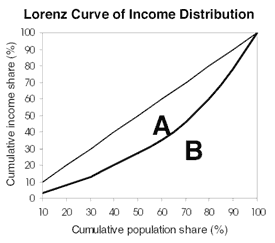Please see section 4c, Equality, Equity and Policy of the website for more detail.
Some definitions to remember:
Equality = sameness
Inequality = unequal
Equity = fairness
Inequity = unfair or unjust
Inequalities in healthcare
Attempts to reduce health inequalities form a major part of recent and current UK health policy. These are largely focused on reducing geographical inequalities (variations) in health outcomes and provision as well as inequalities relating to different groups within society.
The inverse care law states that the availability of good medical care tends to vary inversely with the need for it in the population served.[14]
Health inequalities are endemic in society. Where a person is born influences how long they will live. Following publication of the NHS Plan (2000) the UK government introduced a national target aiming to reduce health inequalities by narrowing the health inequalities gap as measured by life expectancy and infant mortality.
The England Health and Social Care Act 2012 introduced, for the first time, legal duties to reduce health inequalities, with specific duties placed upon clinical commissioning groups (CCGs) and NHS England [15].
These organisations must give regard to the need to reduce inequalities between patients in access to, and outcomes from healthcare services and to ensure services are provided in an integrated way where this might reduce health inequalities.
Variations in health care practice occur at many levels from the individual practitioner, to healthcare organisation, to country. Some variations are justified in terms of patient preference or underlying condition, whilst others are not. These can be classified as unwarranted variations and fall into 3 types:
- Effective care: clinical evidence supports different treatments
- Preference-sensitive care: where alternative valid treatment options are available and variations are caused by patients exercising choice
- Supply-sensitive care: variations reflect the different availability of alternative treatment approaches. [16]
Measuring health inequalities can be achieved by:
- Measuring health need (measuring demand through health needs assessment - see section ‘Participatory needs assessment’)
- Measuring access to health care (measuring supply - see section ‘Measures of supply and demand’) health care use e.g. avoidable admissions, barriers to admission e.g. waiting lists, patients’ perceptions of healthcare provision
- Measuring quality of health care (see section ‘Principles of evaluation’).
The Gini co-efficient adapted from World Bank, 2008 [17]
The Gini-coefficient of inequality is a commonly cited measure of inequality and is shown by a Lorenz curve of income distribution. The Lorenz curve (B) plots the share of cumulative income enjoyed by the relative share of the population – on the curve shown below 40% of the population obtains 20% of the total income. Curve (A) is the line of total equality whereby 40% of the population obtain 40% of the total income. The difference between the 2 curves, Gini-coefficient, indicates the degree of inequality of distribution. A co-efficient of 0 reflects complete equality whilst 1 indicates complete inequality.

Equity in healthcare
Many factors influence health including genetic factors, meaning that complete equality of health is never achievable. Equalising health can be considered as paternalistic because it does not allow for individual preferences such as the choice to smoke. Aristotle’s formal theory of distributive justice makes the distinction between vertical and horizontal equity: horizontal equity refers to equity between people with the same health care needs, whilst vertical equity refers to those with unequal needs who should receive different or unequal health care.[18]
i) Vertical equity – is the unequal treatment of unequals and can be justified on the basis of morally relevant factors, however, morally irrelevant factors should not be the basis for employing vertical equity:
|
Morally relevant factors: Need |
Morally irrelevant factors: Age/sex* |
*unless ability to benefit depends on these factors
ii) Horizontal equity – equal treatment of equals
That is to say, vertical equity can be justified in healthcare if morally relevant factors apply. However, morally irrelevant factors are not grounds for justifying vertical equity.
Commissioners of health care are constantly faced with decisions regarding equity, largely as a result of the need to prioritise and ultimately ration health care to conform to budgetary restraints. Common practice today is for commissioners to implement priority setting policies for the fair distribution of health care resources, largely based on the distinction between morally relevant and irrelevant factors. However, not all moral decisions will satisfy all and therefore any decision-making process regarding priority setting should be about achieving consensus and consistency rather than necessarily achieving the right answer.
References
- [14] Tudor Hart J, 1971. The inverse care law, Lancet 696, pp405-12
- [15] https://www.england.nhs.uk/wp-content/uploads/2015/12/hlth-inqual-guid-…
- [16] Pencheon et al. Oxford Handbook of Public Health practice, 2nd edition, chapter 6, p461.
- [17] www.worldbank.org
- [18] Wonderling et al, Introduction to Health Economics, OUP 2005
© Rosalind Blackwood 2009, Claire Currie 2016
